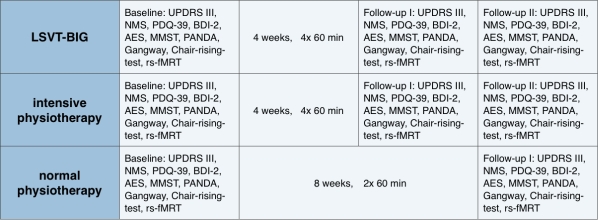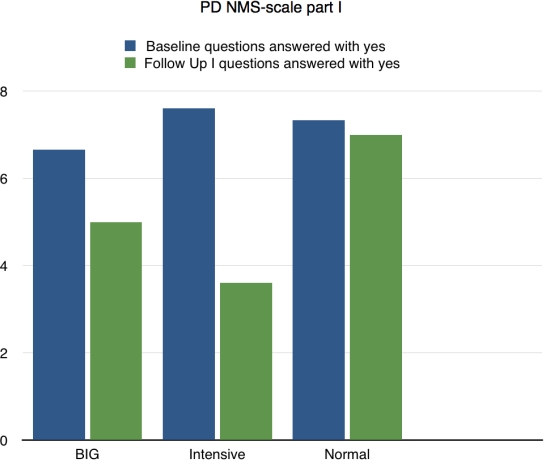Session Information
Date: Wednesday, June 22, 2016
Session Title: Parkinson's disease: Neuroimaging and neurophysiology
Session Time: 12:00pm-1:30pm
Location: Exhibit Hall located in Hall B, Level 2
Objective: To evaluate (1) the changes of non-motor symptoms such as depression, sleep disorders, pain and cognitive deficits in PD by practicing LSVT BIG therapy in comparison to intensified or conventional physiotherapy and (2) to display the effects of intensive motor-training on the motor network by rs-fMRI-analysis.
Background: Previous studies about LSVT BIG for PD patients have shown an improvement of motor symptoms pre vs. post therapy. However, they did not explore whether non-motor symptoms are improved by this intense training. Furthermore it is unclear, which motor network hubs are mostly altered through intensive physiotherapy.
Methods: Three groups of PD patients (n=20 per group) are randomized into a) LSVT-BIG training (4 weeks, 4 times per week, 60 minutes each session), b) intensive physiotherapy with an individual training plan (same schedule as LSVT BIG group) or c) regular physiotherapy (8 weeks, 2 times per week, 60 minutes each session). Changes in non-motor symptoms are evaluated according to the NMS-Score. Quality of life is evaluated by the PDQ-39, psychometric functions by BDI-2, AES, PANDA and MMST. For the evaluation of motor functions the UPDRS III, gangway and chair-rising-test are used. Resting-state fMRI analysis focus on motor network activity. All outcome parameters are assessed in the week before physiotherapy (baseline) and in the week after the last session (follow-up I). A second follow up for LSVT BIG and intensive physiotherapy is done four weeks after the therapy has ended. 
Results: The study is actually recruiting. At the time of the abstract submission 11 patients were included (mean age 64.6 (SD 7.1) yrs, mean disease duration 5.27 (SD 3.55) yrs). Preliminary data show significant improvements in AES comparing intensive physiotherapy/LSVT-BIG with regular physiotherapy. Improvements were found in BDI-2 and NMS part I (30 yes/no questions) but are not yet significant. LSVT BIG and intensive physiotherapy do not show significant differences until now and seem to achieve similar results. Resting-state fMRI-data are not yet analyzed but will be presented at the time of the poster presentation. 
Conclusions: These very preliminary data suggest that LSVT BIG/intensive physiotherapy likewise improve NMS. Furthermore they improve stride length and gait velocity more than conventional physiotherapy. Concerning cognitive functions the data have yet not shown significant changes.
To cite this abstract in AMA style:
F. Schaible, F. Schwartz, T. v. Eimeren, C. Eggers. Behavioral and neuroimaging effects of LSVT-BIG and conventional physiotherapy in Parkinson’s disease [abstract]. Mov Disord. 2016; 31 (suppl 2). https://www.mdsabstracts.org/abstract/behavioral-and-neuroimaging-effects-of-lsvt-big-and-conventional-physiotherapy-in-parkinsons-disease/. Accessed March 31, 2025.« Back to 2016 International Congress
MDS Abstracts - https://www.mdsabstracts.org/abstract/behavioral-and-neuroimaging-effects-of-lsvt-big-and-conventional-physiotherapy-in-parkinsons-disease/
